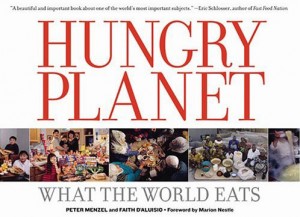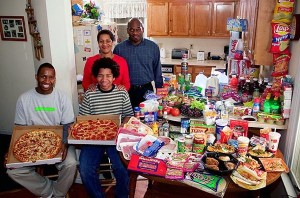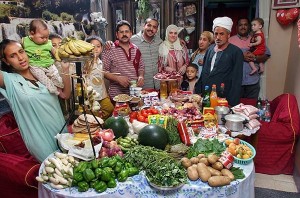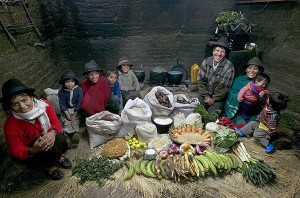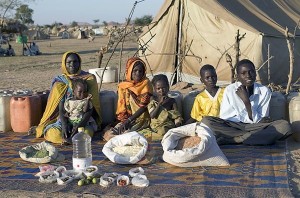From North Carolina to Chad: Families and Food March 10, 2012
Author: Beach Combing | in : Actualite , trackbackAn ‘ill’ day with interesting complications in the throat area so Beach is going to go off topic with this extraordinary book he recently stumbled upon: Hungry Planet: What the World Eats (Peter Menzel 2005). This exercise in photo-journalism has a fair bit of manipulation behind it: but the idea itself is an extraordinarily simple and effective one. Turn up in about 30 of the 200 odd countries in the world and then photograph a family with the food that they expect to eat in one week.
Of course – and this is where the manipulation comes in – there is going to be quite a lot of picking and choosing. As you cannot visit every single country how do you decide which countries to choose? And as you are going to have to choose a region within a country how do you choose which part of the country, never mind what family in that region?
In the United States you could pick, as the editor decided to here, a family from North Carolina who seem to live almost without fresh food: there is a solitary bunch of grapes. Or you could choose a wealthy white family from southern California with their vegan chef as the editor did not. Naturally, a junk-food family that can buy lots of cheap but bad food comes closer to the stereotype of American families (Michael Pollin etc) and is perhaps closer to a genuine median?
But if choices are not always scientific the effect is nevertheless striking. This book is an efficient twenty-first century equivalent of parents telling their children ‘Eat that! There are children starving in Africa!’ Of which more below… Going down the scale we come next to a Polish family with their predictable predominance of root and ground vegetables and reduced processed food.
Then Egypt where processed foods are becoming increasingly a luxury item: indeed, from friends in Egypt Beachcombing knows that the ‘sophisticated’ diet is a modern processed one, that naturally cannot be afforded by most of the population.
From here we come to a very rural family in Ecuador: this, Beachcombing should note, is not how most people in Ecuador eat, nor is it how most people in Ecuador dress!
Then finally and most tragically this image of a refugee family in Chad, a country that has spent most of the last generation as the armpit of the world: the result of a corrupt political class, unstable neighbours and lots of guns.
The American family spends about 250 dollars a week. The fatherless bairns in this picture are, with their mother, all fed on less than 1 dollar a week. They can’t get much more than a thousand calories a day from this mush of beans and grains: there are six of them, five of them in a phase of acute growth.
Beachcombing is always looking for striking and unusual books: drbeachcombing AT yahoo DOT com

